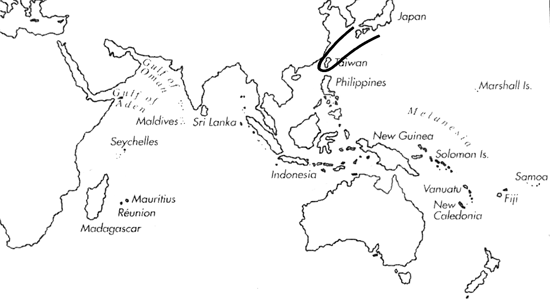Range: Japan to Taiwan.
Description: Medium-sized to moderately large, moderately solid to solid. Last whorl ventricosely conical; outline convex adapically, less so or straight below. Shoulder subangulate to rounded. Spire of low to moderate height, outline straight to slightly convex. Larval shell of about 2.75 whorls, maximum diameter about 0.9 mm. About first 4 postnuclear whorls tuberculate. Teleoconch sutural ramps convex to almost flat, with 2 increasing to 4 spiral grooves in early whorls, and many spiral striae in later whorls. Last whorl with wrinkled spiral ribs abapically, often followed by spiral threads.
| Shell Morphometry | ||
|---|---|---|
| L | 45-80 mm | |
| RW | 0.18-0.34 g/mm | |
| (L 45-65 mm) | ||
| RD | 0.55-0.62 | |
| PMD | 0.75-0.85 | |
| RSH | 0.10-0.15 | |
Colour violet blending with white. Last whorl encircled with continuous, broad or narrow, violet to tan bands above and below a narrow light band at centre. Solid or dotted brown spiral lines and dark brown axial blotches and flames vary in number, arrangement and prominence; form kirai (Pl. 16, Fig. 3) without axial flames and blotches. Larval whorls orangish red. Teleoconch sutural ramps with variably broad reddish to blackish brown radial blotches. Aperture white or pale violet.
Periostracum dark brown, thick and opaque.
Habitat and Habits: In 10-100 mm; typical form to 30 m, form kirai in 35-100 m.
Discussion: C. fulmen resembles C. kinoshitai and C. circumcisus.; for comparison see the DISCUSSIONS of these species. The holotype of C. wistaria is a light violet shell with only traces of spiral banding. Its shape and colouration favour provisional assignment to C. fulmen.

C. fulmen range map
This section contains verbatim reproductions of the accounts of 316 species of Conus from the Indo-Pacific region, from Manual of the Living Conidae, by Röckel, Korn and Kohn (1995). They are reproduced with the kind permission of the present publisher, Conchbooks.
All plates and figures referred to in the text are also in Röckel, Korn & Kohn, 1995. Manual of the Living Conidae Vol. 1: Indo-Pacific Region.
The range maps have been modified so that each species account has it own map, rather than one map that showed the ranges of several species in the original work. This was necessary because each species account is on a separate page on the website and not confined to the order of accounts in the book.